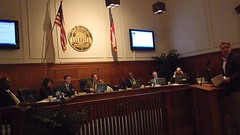Here’s the draft resolution on Citizens Wishing to be Heard.
Previously we posted that
on Tuesday’s Lowndes County Commission agenda is an item about:
5. Resolution Establishing Policies and Procedures for Citizens Wishing to Be Heard and Consideration of Lowndes County Board of Commissioners Policies and Procedures for Citizens Wishing to Be Heard
Today I went by the county palace (hey, they call it that, too!)
and asked Paige Dukes, the County Clerk, what was in the old resolution
and what’s in the new draft resolution.
She said there was no old resolution,
and a bit later she sent me the new draft resolution,
which is in the PDF below.
 From: “Paige Dukes” <paiged@lowndescounty.com>
From: “Paige Dukes” <paiged@lowndescounty.com>
Date: Mon, 24 Jan 2011 16:32:35 -0500
To: “John S. Quarterman” <jsq@quarterman.org>
Subject: Resolution Draft 1.24.2011.pdf – Adobe Acrobat Professional
Resolution Draft 1.24.2011.pdf
It’s a PDF of a scan of a paper page, so I don’t have the plain text.
If somebody wants to type it in and send it to me, have at it.
See you 5:30 PM tomorrow evening (Tuesday 25 Jan 2011) at 327 N. Ashley Street, Valdosta, GA 31601.
They start on the dot or slightly early, and it’s a light agenda,
so be on time and don’t blink or you’ll miss it.
-jsq
 You could hear this after
Matt Flumerfelt spoke in the previous post,
but let’s pull it out separately here.
This is Ashley Paulk recommending that people come in and talk
to their commissioners, and he says:
You could hear this after
Matt Flumerfelt spoke in the previous post,
but let’s pull it out separately here.
This is Ashley Paulk recommending that people come in and talk
to their commissioners, and he says:






